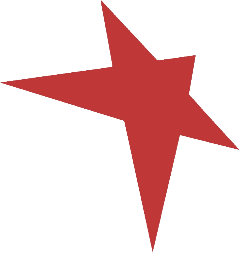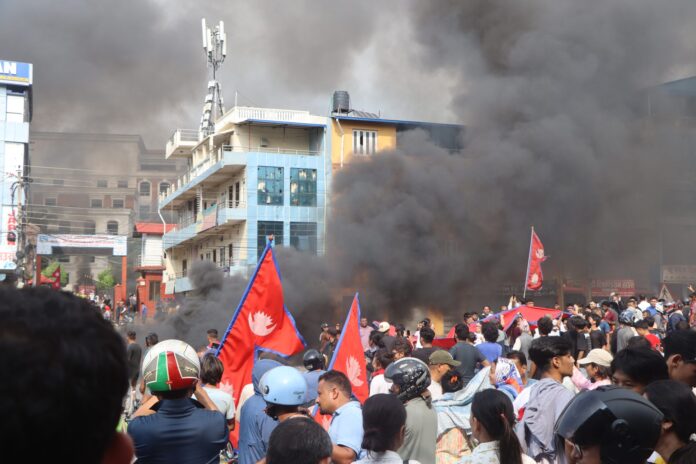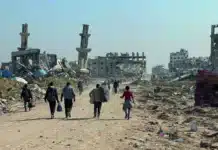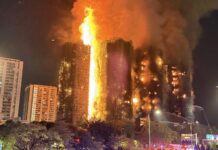The working class and poor people in Nepal can’t afford another rotten government of the rich
Vilgot Karlsson, article in Offensiv, paper of Socialistiskt Alternativ (ISA Sweden)
(This article was first published on 9 October 2025)
It has been exactly one month since Nepal was shaken by a short-lived but intense protest movement that came to be known as the ‘Generation Z protests’. Five days of struggle, protests and riots succeeded in literally chasing the government out of office. New elections have been called for 5 March 2026, but it remains to be seen whether the country’s discontented young generation will see any real change, or the same injustices under a new regime.
The protest movement erupted in response to the government’s decision on 4 September to ban 26 social media platforms, including Facebook, YouTube, Snapchat, X (formerly Twitter), WhatsApp, and Reddit, on the grounds that their owners had refused to register with the Information and Communications Authority.
The real motive behind the censorship was likely an attempt to prevent the continued spread of a new viral trend on social media, ‘#NepoBaby,’ which drew unwanted attention to the ruling class by exposing the luxurious lifestyles of politicians and their children, in stark contrast to the average population.
$1,400 a year
The social media ban was merely the catalyst that gave physical form to growing discontent, spilling out from social media onto the streets of Kathmandu. The protest movement is rooted in the grotesque difference in living standards between rich and poor, widespread corruption, and high youth unemployment (20 per cent among young people aged 15-24). On average, a person in Nepal earns $1,400 a year. Three-quarters of all households depend on money sent by family members working abroad, known as remittances, which account for nearly a third of the country’s GDP. On average, 1,700 Nepalese emigrate every day.
The idea of demonstrating was discussed extensively on platforms that had not already been banned. The initiative for a demonstration was taken by the youth-led NGO Hami Nepal. On 8 September, tens of thousands of young people gathered outside the parliament building in Kathmandu. The demonstration began peacefully, but due to its loose organisation and lack of leadership, the protests escalated and became violent in places, with stone throwing, to which the military responded with rubber bullets, water cannons, tear gas and live ammunition.
Presidential palace on fire
The protests continued despite a curfew and state violence. The parliament was stormed, and the presidential palace and the Supreme Court were set on fire, along with over three hundred government buildings across the country. Nineteen demonstrators were killed by the military and over 300 were injured on the first day. By the end of the uprising 75 people had been killed and over 2000 injured. That evening, the government lifted the ban on social media.
Since 1990, Nepal has had 27 prime ministers. With very few exceptions, the premiership during that period has rotated between the three largest parties – the Communist Party of Nepal (United Marxist-Leninists), the Communist Party of Nepal (Maoists) and the Nepali Congress Party (Social Democrats). The fourth largest is the Rastriya Swatantra Party (RSP), which was formed in 2002 and describes itself as neither left nor right. The fifth largest is the monarchist, Hindu nationalist Rastriya Prajatantra Party (RPP).
On 9 September, Prime Minister K. P. Sharma Oli resigned. It was his fourth term as prime minister since 2015, most recently in 2024 in a coalition between the Communist Party of Nepal (United Marxist-Leninists), to which he himself belongs, and the Nepali Congress Party. Oli was often criticised for turning a blind eye to corruption and nepotism. This year alone, more than ten major scandals involving current or former ministers have been uncovered, including bribery, embezzlement and fraud, according to the Kathmandu Post.
New government
Following intervention by Army chief Ashok Raj Sigdel, who negotiated with the self-appointed leaders of the protests, Nepal has been ruled since 12 September by a transitional government led by the country’s first female prime minister, former Chief Justice of the Supreme Court, Sushila Karki. The election was held on the Discord server (a platform for digital social interaction and large networks) ‘Nepal’s Parliament’ with over 100,000 members on 10 September, and was preceded by a politicians’ Q&A. Of a total of 7,715 votes cast, Karki received just under 50 per cent and took office on 12 September as interim prime minister. She was endorsed by the mayor of Kathmandu, former rapper Balen Shah, who has a strong support among the youth. The transitional government consists of lawyers, civil servants, agency heads and former ministers with no party affiliation. The legal adviser of Balen Shah, Om Prakash Aryal, became home secretary. The new government has already decided that the promised election will be paid for with new cuts.
The protests, which had continued even after Oli’s resignation on 9 September in response to the military’s excessive use of force and the killing of demonstrators, ceased after the Discord election. The movement succeeded in bringing down the government, but like other ‘Generation Z protests’ in recent years (Sri Lanka, Bangladesh,, Kenya, Indonesia), it was loosely organised, lacked a democratically elected leadership and raised limited demands against corruption, injustice or the incumbent government without fundamentally fighting for a completely new social system.
The monarchy was abolished in 2008 and replaced by political nepotism. The protest movement succeeded in drawing attention to injustices and bringing down the government, but did not take the fight further, instead placing its future in the hands of old politicians and lawyers.
The working class and poor people in Nepal can’t afford another rotten government of the rich. The revolutionary movement should fight for a genuinely democratic constituent assembly, made up of recallable delegates on a workers’ wage rather than a new cast of corrupt, unaccountable officials. A revolutionary government would be able to take the key levers of the Nepalese economy into democratic public ownership, under workers’ control and management in order to plan the economy for the benefit of all rather than to enrich a tiny layer at the top of society.




